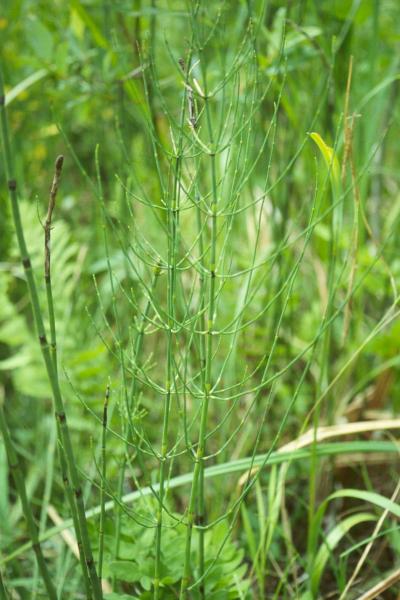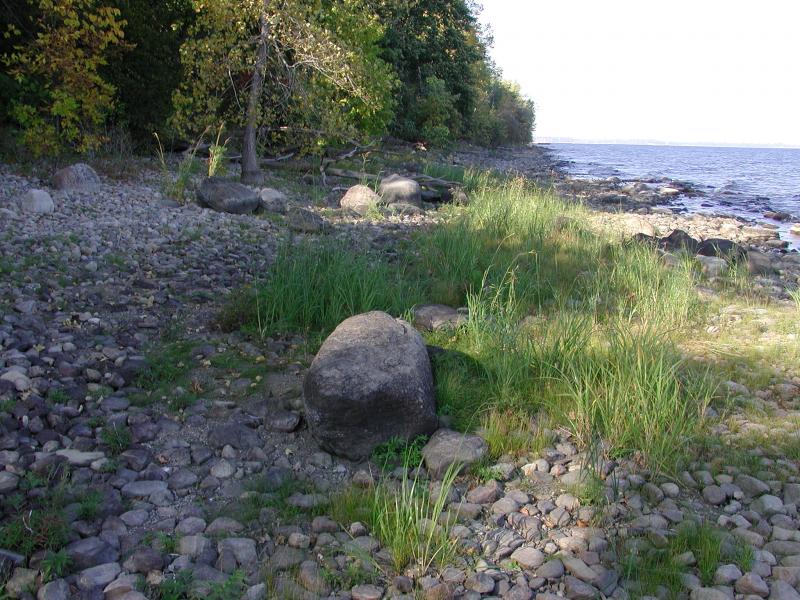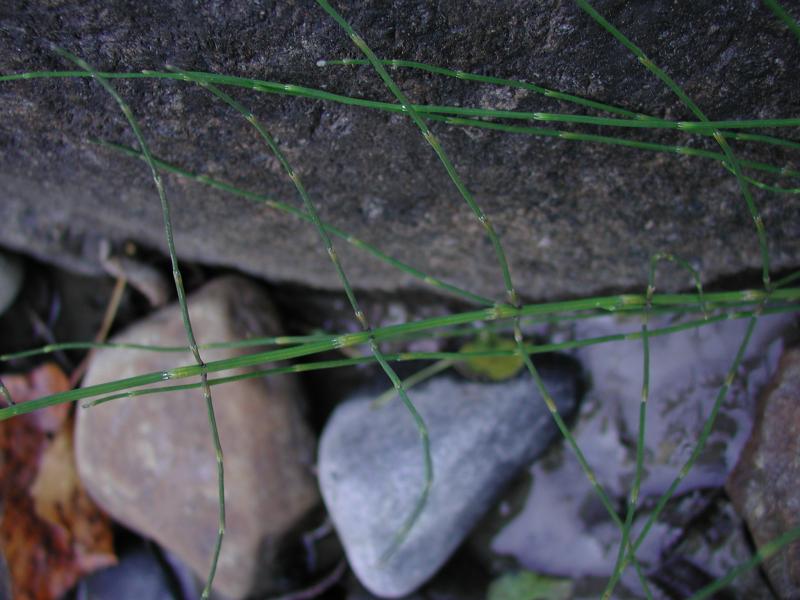Marsh Horsetail
Equisetum palustre L.
- Class
- Equisetopsida (Horsetails)
- Family
- Equisetaceae (horsetail family)
- State Protection
- Threatened
Listed as Threatened by New York State: likely to become Endangered in the foreseeable future. For animals, taking, importation, transportation, or possession is prohibited, except under license or permit. For plants, removal or damage without the consent of the landowner is prohibited.
- Federal Protection
- Not Listed
- State Conservation Status Rank
- S2
Imperiled in New York - Very vulnerable to disappearing from New York due to rarity or other factors; typically 6 to 20 populations or locations in New York, very few individuals, very restricted range, few remaining acres (or miles of stream), and/or steep declines.
- Global Conservation Status Rank
- G5
Secure globally - Common in the world; widespread and abundant (but may be rare in some parts of its range).
Summary
Did you know?
Species in the genus Equisetum are living members of a group of plants, the sphenophytes, that dominated the landscape during the age of dinosaurs. Some grew up to 100 feet tall but today's plants of the Equisetum family are much smaller, even though some species in South America may reach 15 feet in height.
State Ranking Justification
There are eight existing populations and most of them are in good to excellent condition. There are 14 historical populations and some of them still need to be resurveyed.
Short-term Trends
The short-term trend is relatively stable as most populations have remained the same although one large population showed a substantial decline after one survey.
Long-term Trends
This plant was never common in New York but it seems to have declined over the last 100 years as some of the wetlands where it occurred have been destroyed or invaded by phragmites or purple loosestrife.
Conservation and Management
Threats
Some riverside plants may be threatened by damage from storms or by trampling by people using the banks for fishing or bathing. There is purple loosestrife present at one population but it is difficult to know if it will be a problem.
Conservation Strategies and Management Practices
Protect populations from direct impact by humans and from the invasion of aquatic invasive plants like phragmites and purple loosestrife. Hydrology of the area should be maintained to protect the water level of the wetlands.
Research Needs
Research needs to be done into the habitat preference of this species since it occurs in small areas of larger wetlands. Water pH preference needs to be determined and population augmentation should be studied.
Habitat
Habitat
In New York, marsh horsetail has been found in a diversity of wetland habitats, often, though not always, at sites influenced by limestone bedrock (New York Natural Heritage Program 2007). Marshes, wet woods, meadows, wet shores, etc., often in calcareous soil (Fernald 1970). Streambanks, wet meadows, and marshes (Gleason & Cronquist 1991).
Associated Ecological Communities
- Deep emergent marsh
(guide)
A marsh community flooded by waters that are not subject to violent wave action. Water depths can range from 6 in to 6.6 ft (15 cm to 2 m). Water levels may fluctuate seasonally, but the substrate is rarely dry, and there is usually standing water in the fall.
- Medium fen
(guide)
A wetland fed by water from springs and seeps. These waters are slightly acidic (pH values generally range from 4.5 to 6.5) and contain some dissolved minerals. Plant remains in these fens do not decompose rapidly and thus the plants in these fens usually grow on older, undecomposed plant parts of woody material, grasses, and mosses.
- Red maple-hardwood swamp*
(guide)
A hardwood swamp that occurs in poorly drained depressions, usually on inorganic soils. Red maple is usually the most abundant canopy tree, but it can also be codominant with white, green, or black ash; white or slippery elm; yellow birch; and swamp white oak.
* probable association but not confirmed.
Associated Species
- Alisma subcordatum (southern water-plantain)
- Alnus serrulata (smooth alder)
- Artemisia vulgaris (mugwort)
- carex michauxiana
- Carex aurea (golden-fruited sedge)
- Carex cristatella (crested sedge)
- Carex lurida (sallow sedge)
- Carex stipata
- Carex vulpinoidea (fox sedge)
- Cornus racemosa (gray dogwood, red-panicled dogwood)
- Dichanthelium
- Equisetum arvense (field horsetail, common horsetail)
- Equisetum fluviatile (river horsetail)
- Equisetum scirpoides (dwarf scouring-rush)
- Eutrochium maculatum
- Geum
- Impatiens capensis (spotted jewelweed, spotted touch-me-not)
- Iris versicolor (blue flag)
- Juncus effusus
- Juncus tenuis (path rush)
- Lonicera
- Lythrum salicaria (purple loosestrife)
- Menyanthes trifoliata (buck-bean)
- Mimulus ringens (Allegheny monkey-flower)
- Packera aurea (golden ragwort)
- Penthorum sedoides (ditch stonecrop)
- Phalaris arundinacea (reed canary grass)
- Populus deltoides
- Ranunculus hispidus (woodland butter-cup, woodland crow-foot)
- Solidago canadensis
- Sparganium
- Toxicodendron vernix (poison-sumac)
- Trollius laxus (spreading globeflower)
- Typha latifolia (wide-leaved cat-tail)
- Veronica scutellata (marsh speedwell)
Range
New York State Distribution
There are widely scattered occurrences of marsh horsetail throughout the the state.
Global Distribution
Equisetum palustre is found across the northern tier of the United States, through most of Canada and Alaska, and into Eurasia including China, Korea, and Japan.
Identification Comments
General Description
All horsetails are perennial from rhizomes, have hollow stems with prominent nodes and whorled leaves, and produce spores rather than seeds. Marsh horsetail has annual above-ground stems, with the fertile and sterile stems alike, and it fruits in the summer. The stem has 5-10 deep grooves, reducing the size of the central cavity to less than 1/3 the diameter of the stem. The leaf sheaths are green, loose, and expanded upward, with 10 or fewer white-margined teeth 3-7mm long. The branches are 5-6 angled, fairly short, and usually ascending and simple. The cone is 1 -3.5 cm long, blunt, and deciduous.
Best Life Stage for Proper Identification
While fruiting stems may aid in identification, this species can be identified from vegetative stems as well.
Similar Species
Equisetum fluviatile and E. laevigatum both have a stem with (9-32) shallow ridges and a central cavity that is more than half the diameter of the stem. Equisetum pratense and E. sylvaticum have different fertile and sterile stems, and fruit (produce spores) in the spring. In their vegetative form they differ from E. palustre by normally having stems with more than 10 ridges, and sheaths with teeth only 1-2 mm long.
Best Time to See
Marsh horsetail produces spores in June and July.
- Vegetative
- Fruiting
The time of year you would expect to find Marsh Horsetail vegetative and fruiting in New York.
Marsh Horsetail Images
Taxonomy
Marsh Horsetail
Equisetum palustre L.
- Kingdom Plantae
- Phylum Sphenophyta
- Class Equisetopsida
(Horsetails)
- Order Equisetales
- Family Equisetaceae (horsetail family)
- Order Equisetales
- Class Equisetopsida
(Horsetails)
- Phylum Sphenophyta
Synonyms
- Equisetum palustre var. americanum Vict.
- Equisetum palustre var. ramosissimum Peck
Additional Resources
Best Identification Reference
Flora of North America Editorial Committee. 1993. Flora of North America, North of Mexico. Volume 2. Pteridophytes and Gymnosperms. Oxford University Press, New York. 475 pp.
Other References
Burnham, S.H. 1971. The ferns of the Lake George flora, New York. American Fern Journal 7:54-63.
Crow, Garrett E. and C. Barre Hellquist. 2000. Aquatic and wetland plants of northeastern North America: A revised and enlarged edition or Norman C. Fassett's a manual of aquatic plants. Volume two angiosperms: Monocotyledons. The University of Wisconsin Press. Madison, Wisconsin. 456 pp.
Fernald, M.L. 1950. Gray's manual of botany. 8th edition. D. Van Nostrand, New York. 1632 pp.
Gleason, Henry A. and A. Cronquist. 1991. Manual of Vascular Plants of Northeastern United States and Adjacent Canada. The New York Botanical Garden, Bronx, New York. 910 pp.
Haines, Arthur and Thomas F. Vining. 1998. Flora of Maine. A Manual for Identification of Native and Naturalized Vascular Plants of Maine.
Holmgren, Noel. 1998. The Illustrated Companion to Gleason and Cronquist's Manual. Illustrations of the Vascular Plants of Northeastern United States and Adjacent Canada. The New York Botanical Garden, Bronx, New York.
Lellinger, David B. 1985. A Field Manual of the ferns and fern-allies of the United States and Canada. Smithsonian Institution, Washington, D.C. 389 Pp.
New York Natural Heritage Program. 2010. Biotics database. New York Natural Heritage Program. New York State Department of Environmental Conservation. Albany, NY.
New York Natural Heritage Program. 2024. New York Natural Heritage Program Databases. Albany, NY.
Ogden, E.C., J.K. Dean, C.W. Boylen, R.B. Sheldon 1976. Field guide to the aquatic plants of Lake George, New York. New York State Museum Bull. 426.
Weldy, T. and D. Werier. 2010. New York flora atlas. [S.M. Landry, K.N. Campbell, and L.D. Mabe (original application development), Florida Center for Community Design and Research http://www.fccdr.usf.edu/. University of South Florida http://www.usf.edu/]. New York Flora Association http://newyork.plantatlas.usf.edu/, Albany, New York
Weldy, Troy W. and David Werier. 2005. New York Flora Atlas. [S.M. Landry, K.N. Campbell, and L.D. Mabe (original application development), Florida Center for Community Design and Research. University of South Florida]. New York Flora Association, Albany, NY. Available on the web at (http://newyork.plantatlas.usf.edu/).
Links
About This Guide
Information for this guide was last updated on: January 18, 2008
Please cite this page as:
New York Natural Heritage Program. 2024.
Online Conservation Guide for
Equisetum palustre.
Available from: https://guides.nynhp.org/marsh-horsetail/.
Accessed July 26, 2024.


